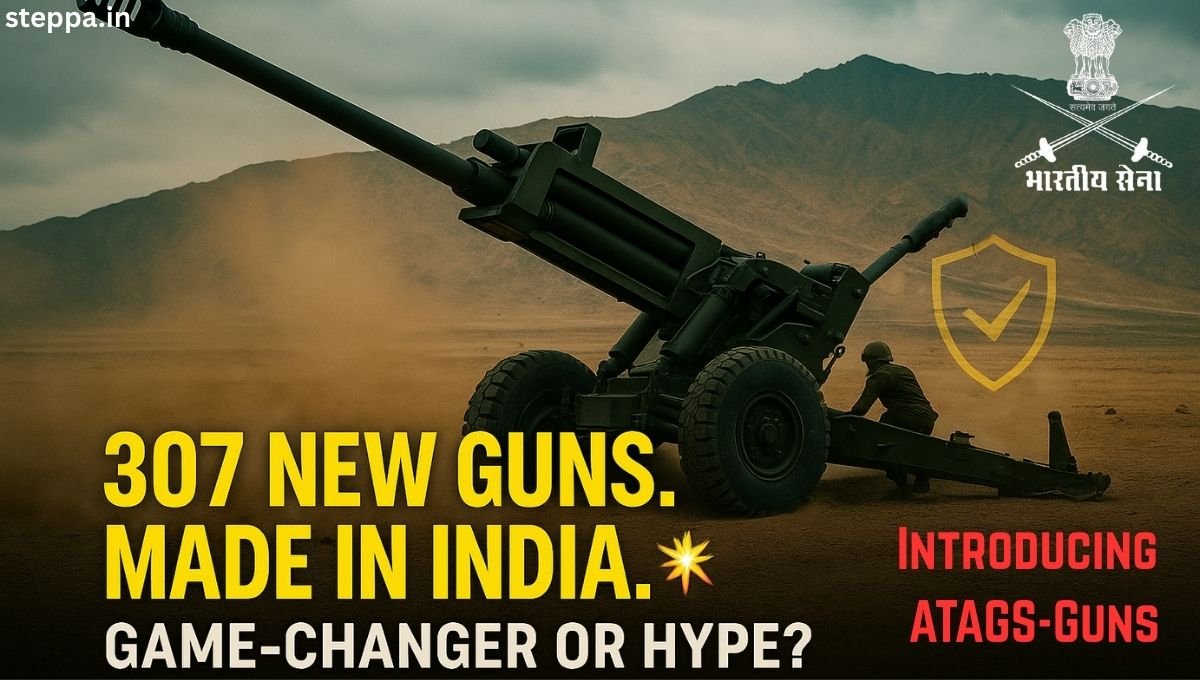India just took a bold leap in modernising its firepower. The Defence Ministry has confirmed a massive step—307 units of the Advanced Towed Artillery Gun System (ATAGS) will be inducted into the Indian Army in the next five years.
And the best part? These aren’t imports. They’re Indian Army homegrown artillery.
So, What Exactly Is the ATAGS?
Built under the ‘Make in India’ initiative, ATAGS is a 155mm/52 calibre artillery gun that’s designed for long-range precision and rugged terrain. Developed by DRDO’s Armament Research and Development Establishment (ARDE) in Pune, it’s been called a “mission-mode success.”
The project kicked off in 2012, and by 2022, full-scale development, testing, and manufacturing were completed. That’s honestly pretty fast by defence standards.
What Makes This Gun So Special?
Let’s break it down:
- Huge Range: Can hit targets up to 48 km away
- All-Electric Drive: For gun laying and ammo handling, meaning fewer mechanical failures
- Shoot-and-Scoot: Can fire and relocate within 85–90 seconds to avoid enemy counterattack
- High Burst Fire Rate: Fires 6 rounds in 30 seconds or 5 rounds per minute
- Indigenous Content: Roughly 75% made in India
- Adaptability: Works in desert and mountain conditions without needing fancy adjustments
- Tech-Savvy: Compatible with digital fire control systems and battlefield networks
Why Is This a Big Deal?
India’s artillery systems were long overdue for an upgrade. The Army has been using older 105mm and 130mm guns for decades. These don’t match the range, speed, or tech capabilities of what modern warfare demands today.
ATAGS, meanwhile, is designed to fit into a fast-moving, precision-strike battlefield—the kind we’re more likely to face in the future.
Let’s be real: In high-altitude zones like Ladakh or fast-response situations like those seen in Ukraine, speed and range win battles. That’s exactly where ATAGS shines.
ATAGS vs Old Artillery – Quick Look
| Feature | ATAGS | Older Artillery (e.g. 105mm) |
| Calibre | 155mm / 52 | 105mm / 130mm |
| Max Range | Up to 48 km | 17–27 km |
| Burst Fire Capability | 6 rounds in 30 sec | Lower |
| Mobility (Shoot & Scoot) | 85–90 seconds | Not available |
| Electric Handling | Yes | Manual |
| Indigenous Content | ~75% | Low |
| Digital Integration | Fully compatible | Minimal or none |
Production Details and Deployment Plan
The Ministry of Defence signed contracts worth ₹6,900 crore with two major Indian firms—Bharat Forge Limited and Tata Advanced Systems Limited—to get these guns rolling.
Each company will deliver its share of the 307 units over five years, with the first 18 guns expected by February 2027.
These guns won’t sit idle in warehouses either. They’ll actively replace vintage artillery regiments across different operational zones, from plains to high altitudes.
Future Upgrades – Mobile Gun Systems Coming Too
This isn’t the end of the ATAGS journey.
A truck-mounted Mobile Gun System (MGS) variant is currently in development. It’s expected to be ready for user trials by 2026. This version will offer even more flexibility, especially in border zones where towing traditional artillery is slower and riskier.
Real Talk: Why ATAGS Could Be a Global Player
To be fair, this gun doesn’t just compete with legacy Indian systems—it has the potential to challenge globally used platforms like:
- US’s M777 (lighter but less range)
- South Korea’s K9 Vajra (which India already uses in SPH form)
- France’s Caesar system (also truck-mounted, similar class)
If India can show ATAGS’s reliability in the field and secure exports, it could become a strong contender in global arms markets—especially among developing countries looking for budget-friendly, high-performance systems.
Final Word for Indian Army homegrown artillery
The induction of ATAGS marks a defining moment for India’s defence tech evolution. It’s not just about better guns—it’s about self-reliance, battlefield efficiency, and pushing out outdated systems that no longer meet real-world demands.
If all goes well, this system won’t just protect the borders—it might even become a symbol of India’s capability to build cutting-edge defence gear that the world respects.
Also read: DRDO Supercharges India’s Defence Manufacturing: 2,000+ Tech Transfers & 200 Licenses Issued in 2024
